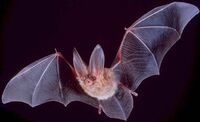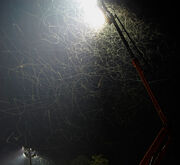(New page: {{ClinPsy}} thumb|200px|right|A [[bat illustrating nocturnal features.]] As an animal behavior, '''nocturnality''' describes [[sleep|sleepin...) |
(tidy) |
||
| Line 1: | Line 1: | ||
{{ClinPsy}} |
{{ClinPsy}} |
||
[[Image:Big-eared-townsend-fledermaus.jpg|thumb|200px|right|A [[bat]] illustrating nocturnal features.]] |
[[Image:Big-eared-townsend-fledermaus.jpg|thumb|200px|right|A [[bat]] illustrating nocturnal features.]] |
||
| − | As an [[animal behavior]], '''nocturnality''' describes [[sleep|sleeping]] during the |
+ | As an [[animal behavior]], '''nocturnality''' describes [[sleep|sleeping]] during the daytime and being active at night - the opposite of the [[diurnal animal|diurnal]] human lifestyle, and that of those animals with which we are most familiar. The intermediate [[crepuscular]] schedule (twilight activity) is also common. Some species are active both during the day and night. Living at night can be seen as a form of [[niche differentiation]], where a species' niche is partitioned not by resources but by time itself, i.e. temporal division of the [[ecological niche]]. It can also be viewed as a form of [[crypsis]], in other words an adaptation to avoid or enhance [[predation]]. There are other reasons for nocturnality as well, such as keeping out of the heat of the day. This is especially true in deserts, where many animals' nocturnal behavior prevents them from losing precious water during the hot, dry daytime. This is an [[adaptation]] that enhances [[osmoregulation]].<ref>N.A.Campbell (1996) ''Biology'' (4th edition) Benjamin Cummings NY. ISBN 0-8053-1957-3</ref> |
Many species which are otherwise diurnal exhibit some nocturnal behaviour; for example, many [[seabird]]s and [[sea turtle]]s attend breeding sites or colonies nocturnally to reduce the risk of predation (to themselves or their offspring) but are otherwise diurnal. Some animals are not really nocturnal and are instead [[crepuscular]], being mostly active in twilight. |
Many species which are otherwise diurnal exhibit some nocturnal behaviour; for example, many [[seabird]]s and [[sea turtle]]s attend breeding sites or colonies nocturnally to reduce the risk of predation (to themselves or their offspring) but are otherwise diurnal. Some animals are not really nocturnal and are instead [[crepuscular]], being mostly active in twilight. |
||
| − | Nocturnal animals generally have highly developed senses of [[hearing (sense)|hearing]] and [[olfaction|smell]], and specially adapted [[eyesight]]. In |
+ | Nocturnal animals generally have highly developed senses of [[hearing (sense)|hearing]] and [[olfaction|smell]], and specially adapted [[eyesight]]. In zoos, nocturnal animals are usually kept in special night-illumination enclosures to reverse their normal [[sleep-wake cycle]] and to keep them active during the hours when visitors will be attempting to see them. |
Some animals, such as [[cat]]s, have eyes that can adapt to both night and day levels of illumination. Others, e.g. [[bushbaby|bushbabies]] and [[bat]]s, can only function at night. |
Some animals, such as [[cat]]s, have eyes that can adapt to both night and day levels of illumination. Others, e.g. [[bushbaby|bushbabies]] and [[bat]]s, can only function at night. |
||
| + | |||
| − | A person who exhibits nocturnal habits is referred to as a [[Night owl (person)|night owl]]. |
||
==Examples== |
==Examples== |
||
| − | [[Image:Moths attracted by floodlight02.jpg|right|thumb|A long |
+ | [[Image:Moths attracted by floodlight02.jpg|right|thumb|A long exposure outside a floodlight showing moth movements.]] |
{{listcruft}} |
{{listcruft}} |
||
The following animals are generally classified as nocturnal: |
The following animals are generally classified as nocturnal: |
||
Revision as of 16:39, 13 December 2007
Assessment |
Biopsychology |
Comparative |
Cognitive |
Developmental |
Language |
Individual differences |
Personality |
Philosophy |
Social |
Methods |
Statistics |
Clinical |
Educational |
Industrial |
Professional items |
World psychology |
Clinical: Approaches · Group therapy · Techniques · Types of problem · Areas of specialism · Taxonomies · Therapeutic issues · Modes of delivery · Model translation project · Personal experiences ·

A bat illustrating nocturnal features.
As an animal behavior, nocturnality describes sleeping during the daytime and being active at night - the opposite of the diurnal human lifestyle, and that of those animals with which we are most familiar. The intermediate crepuscular schedule (twilight activity) is also common. Some species are active both during the day and night. Living at night can be seen as a form of niche differentiation, where a species' niche is partitioned not by resources but by time itself, i.e. temporal division of the ecological niche. It can also be viewed as a form of crypsis, in other words an adaptation to avoid or enhance predation. There are other reasons for nocturnality as well, such as keeping out of the heat of the day. This is especially true in deserts, where many animals' nocturnal behavior prevents them from losing precious water during the hot, dry daytime. This is an adaptation that enhances osmoregulation.[1]
Many species which are otherwise diurnal exhibit some nocturnal behaviour; for example, many seabirds and sea turtles attend breeding sites or colonies nocturnally to reduce the risk of predation (to themselves or their offspring) but are otherwise diurnal. Some animals are not really nocturnal and are instead crepuscular, being mostly active in twilight.
Nocturnal animals generally have highly developed senses of hearing and smell, and specially adapted eyesight. In zoos, nocturnal animals are usually kept in special night-illumination enclosures to reverse their normal sleep-wake cycle and to keep them active during the hours when visitors will be attempting to see them.
Some animals, such as cats, have eyes that can adapt to both night and day levels of illumination. Others, e.g. bushbabies and bats, can only function at night.
Examples

A long exposure outside a floodlight showing moth movements.
- REDIRECT Template:cleanup-laundry
The following animals are generally classified as nocturnal:
- Aye-aye
- Badger
- Cat
- Centipedes
- Civet
- Cockroaches
- Flying squirrels
- Fox
- Giant White-tailed Rat
- Green Sea Turtle
- Hedgehog
- Hyena
- Kangaroo rats
- Kiwi
- Lion
- Lumholtz's Tree-kangaroo
- Moths
- Nightjars
- Oilbird
- Owls
- Potto
- Raccoon
- Red-legged Pademelon
- Skunk
- Sugar glider
- Tiger
- Tree frogs
- Western harvest mouse
- Whippoorwill
- Wombats
- Wolf
See also
References & Bibliography
- ↑ N.A.Campbell (1996) Biology (4th edition) Benjamin Cummings NY. ISBN 0-8053-1957-3
Key texts
Books
Papers
Additional material
Books
Papers
External links
| This page uses Creative Commons Licensed content from Wikipedia (view authors). |